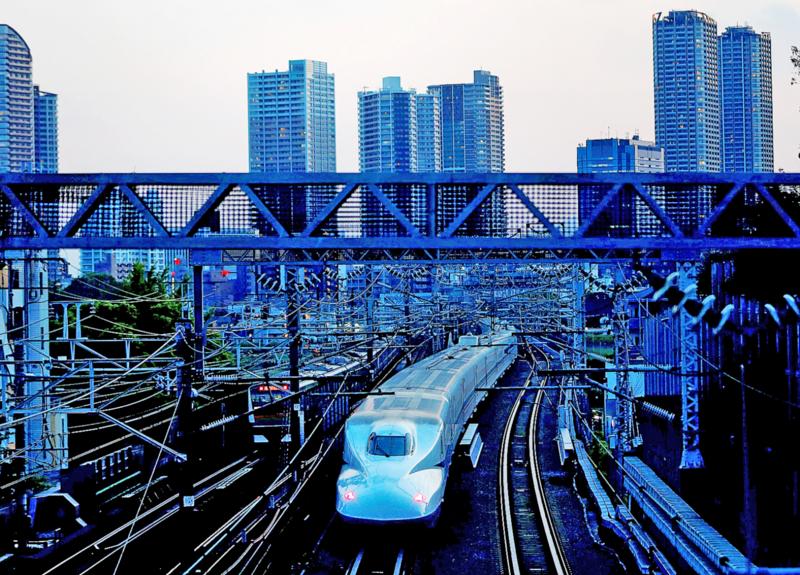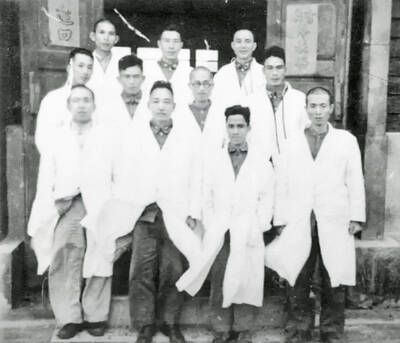When Tokyo last hosted the Olympics, in 1964, the unveiling of a bullet train capable of the improbable speed of 210 kilometers an hour heralded the dawn of a high-tech era in Japan.
Within a decade and a half, innovations such as Sony’s videocassette recorder, Toshiba’s flash memory and Space Invaders, the arcade shoot-em up that revolutionized the gaming industry, made Japan synonymous with global technological superiority, and the talk was of it overtaking the US as the world’s biggest economy.
Today, it seems like another age.

Photo: Reuters
As Tokyo again prepares to host the Games this week, Japan is in a technological funk. Its heyday of setting the pace in televisions, recording devices and computers is far behind it. While Japan can claim credit for the Walkman, Apple Inc came up with the iPhone. More humiliating yet, regional rival South Korea and its tech giant Samsung Electronics Co have overtaken Japan in smartphones and memory chips.
That’s not simply a blow to Japanese national pride; it’s a corporate dilemma and an economic liability just as a fourth wave of COVID-19 robs the country of Olympic spectators and the revenue they’d bring to help spur a rebound from the pandemic. In an increasingly polarized world where the US and China are setting technology and data standards, Japan runs the risk of being left further behind.
Prime Minister Yoshihide Suga is fighting back, with plans to bolster the computer chip industry elevated to a national project on a par with securing food or energy. But executives and government officials in the industry say the solution will also require something else: A fundamental shift in the way Japan has conducted business for decades.
That means reducing red tape, recruiting foreign chipmaking talent and completely dropping “a stubborn insistence on Japan-centricism,” said Kazumi Nishikawa, a director at the IT division of the all-encompassing Ministry of Economy, Industry and Trade, known as METI.
“This made-in-Japan self-reliance approach didn’t work out,” he said. “We want to avoid that this time around.”
Japan may have taken a big step in that direction by enticing Taiwan Semiconductor Manufacturing Co to help rebuild its once dominant chip industry. Last week, Chief Executive Officer C.C. Wei (魏哲家) surprised observers when he said that TSMC was doing “due diligence” on a wafer fab, appearing to confirm long-running speculation over plans by the world’s leading advanced chipmaker to build a facility in Japan.
STIFF COMPETITION
Japan, the world’s No 3 economy after the US and China, is budgeting for hundreds of billions of yen to plow into chips, but it’s a drop in the ocean compared to the kind of money being waved about in the US, where at least US$52 billion is being made available to support domestic semiconductor production. In South Korea, companies like Samsung and SK Hynix are pledging US$450 billion over a decade, while TSMC alone is earmarking US$100 billion over the next three years.
“Some countries are offering support on a different order of magnitude,” making it hard to compete, said Akira Amari, tax chief of the ruling Liberal Democratic Party and a former minister of state for economic and fiscal policy.
Still, he said, the prime minister is “extremely good” at getting things done and is now focused on digitalization and carbon neutrality, two issues linked by semiconductors.
Japan still boasts pockets of excellence in fields including robotics and supercomputing, while Japanese engineers have just shattered the world record for the fastest Internet speed, according to a report last week on interestingengineering.com. In the White House supply chain review published last month, Japan is mentioned 85 times, just ahead of Taiwan and South Korea, and the same number of references as Europe.
Tetsuro Higashi, chairman emeritus at semiconductor equipment maker Tokyo Electron Ltd, said the task of addressing Japan’s decline is not as straightforward as rebuilding one industry. He cited Japan’s semiconductor strengths as Kioxia for memory and Sony’s image sensors, along with component and power-chip makers and chip manufacturing equipment, saying “the strategy has to connect those pieces and form a core.”
“There is a more fundamental sense of crisis,” Higashi, who heads an expert panel advising the government on its chip strategy, said in an interview. “The fear is that if this goes bad, the whole Japanese economy will suffer.”
Like all the world’s most advanced nations, Japan’s technological shortcomings were exposed by the pandemic. Its recognition in Washington belies a decline in technological influence for a variety of reasons, political, economic and cultural.
REDUCED RESEARCH
Take semiconductors, the present government focus: In 1990, Japan held some 50 percent of the global chip market; now it’s 6 percent, according to IC Insights. An analysis of scientific papers submitted to the main semiconductor conferences conducted by the Berlin-based think tank Stiftung Neue Verantwortung shows a precipitous decline in Japanese contributions over the past 25 years, to the extent that China overtook it last year.
“Diminishing market shares seem to go hand-in-hand with decreasing R&D power,” SNV researchers Jan-Peter Kleinhans and Julia Hess write in their report, “Who is developing the chips of the future?”
In a devastating presentation to the lower house Science and Technology Committee last month, independent consultant Takashi Yunogami laid bare Japan’s failings. Japan used to manufacture memory for mainframe computers, where clients demanded high quality and a 25-year guarantee. But come the rise of personal computers, Japanese industry failed to respond, leaving Samsung to offer PC memory with a three-year guarantee at a fraction of the cost. In an increasingly disposable digital age, Japan suffered a “high quality disease.”
The industry’s troubles were compounded by a government response that favored the creation of domestic champions over foreign collaboration. In 1999, Tokyo encouraged the merger of Hitachi and NEC’s memory businesses under the name Elpida, the Greek for “hope.” In 2012 it filed for bankruptcy with liabilities of US$5.5 billion, a victim of plunging prices. It was bought by Micron Technologies of the US.
Like the other officials, however, he saw a ray of hope in terms of Japan’s share of the global market for chip equipment and raw materials, which translates into thousands of small companies making things like wafers and specialized liquids. The government’s best chance is to focus on those few successes and “make the strong stronger,” he said.
Government intervention in the chip industry helped build its dominance in the first place. Ye talk of government help today is poison to some in business, illustrating Suga’s difficulties in securing the support for a technological revival.
TRADE WAR
There’s another reason Japanese officials cite for the country’s relative decline that would sound familiar to Chinese observers: a trade war with the US. Some 40 years ago, spooked by Japan’s rise, the US imposed a requirement to use a certain percentage of US chips or face trade tariffs.
“America saw Japan’s emergence as a threat and pushed back,” said Amari, the ruling party’s tax chief. Yet Japan’s industry was also guilty of complacency, content to focus on the domestic market without venturing out into the world, he said, citing the downfall of Docomo, the first company to connect mobile phones to the internet. It lost out to Samsung and Apple.
Today, the national security issues related to technology mean the government faces “the kind of change that happens once in a hundred years.”
That means it must embrace the challenge or fall behind, he said.
“Japan is good at taking things from zero to one, and not so much at taking them from one to 10,” he said. “Japan wins in technology and loses in business.”

That US assistance was a model for Taiwan’s spectacular development success was early recognized by policymakers and analysts. In a report to the US Congress for the fiscal year 1962, former President John F. Kennedy noted Taiwan’s “rapid economic growth,” was “producing a substantial net gain in living.” Kennedy had a stake in Taiwan’s achievements and the US’ official development assistance (ODA) in general: In September 1961, his entreaty to make the 1960s a “decade of development,” and an accompanying proposal for dedicated legislation to this end, had been formalized by congressional passage of the Foreign Assistance Act. Two

Despite the intense sunshine, we were hardly breaking a sweat as we cruised along the flat, dedicated bike lane, well protected from the heat by a canopy of trees. The electric assist on the bikes likely made a difference, too. Far removed from the bustle and noise of the Taichung traffic, we admired the serene rural scenery, making our way over rivers, alongside rice paddies and through pear orchards. Our route for the day covered two bike paths that connect in Fengyuan District (豐原) and are best done together. The Hou-Feng Bike Path (后豐鐵馬道) runs southward from Houli District (后里) while the

March 31 to April 6 On May 13, 1950, National Taiwan University Hospital otolaryngologist Su You-peng (蘇友鵬) was summoned to the director’s office. He thought someone had complained about him practicing the violin at night, but when he entered the room, he knew something was terribly wrong. He saw several burly men who appeared to be government secret agents, and three other resident doctors: internist Hsu Chiang (許強), dermatologist Hu Pao-chen (胡寶珍) and ophthalmologist Hu Hsin-lin (胡鑫麟). They were handcuffed, herded onto two jeeps and taken to the Secrecy Bureau (保密局) for questioning. Su was still in his doctor’s robes at

Mirror mirror on the wall, what’s the fairest Disney live-action remake of them all? Wait, mirror. Hold on a second. Maybe choosing from the likes of Alice in Wonderland (2010), Mulan (2020) and The Lion King (2019) isn’t such a good idea. Mirror, on second thought, what’s on Netflix? Even the most devoted fans would have to acknowledge that these have not been the most illustrious illustrations of Disney magic. At their best (Pete’s Dragon? Cinderella?) they breathe life into old classics that could use a little updating. At their worst, well, blue Will Smith. Given the rapacious rate of remakes in modern